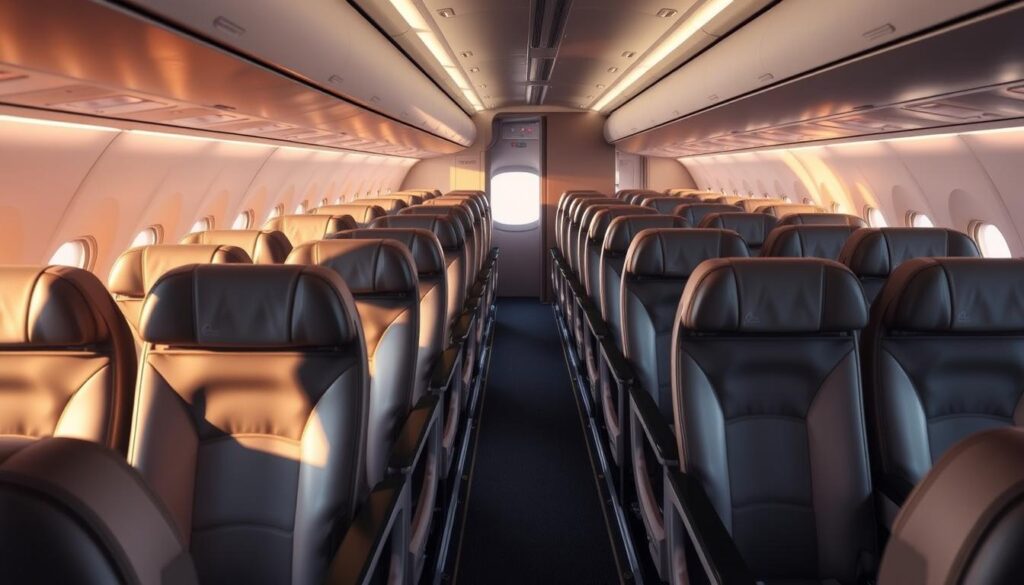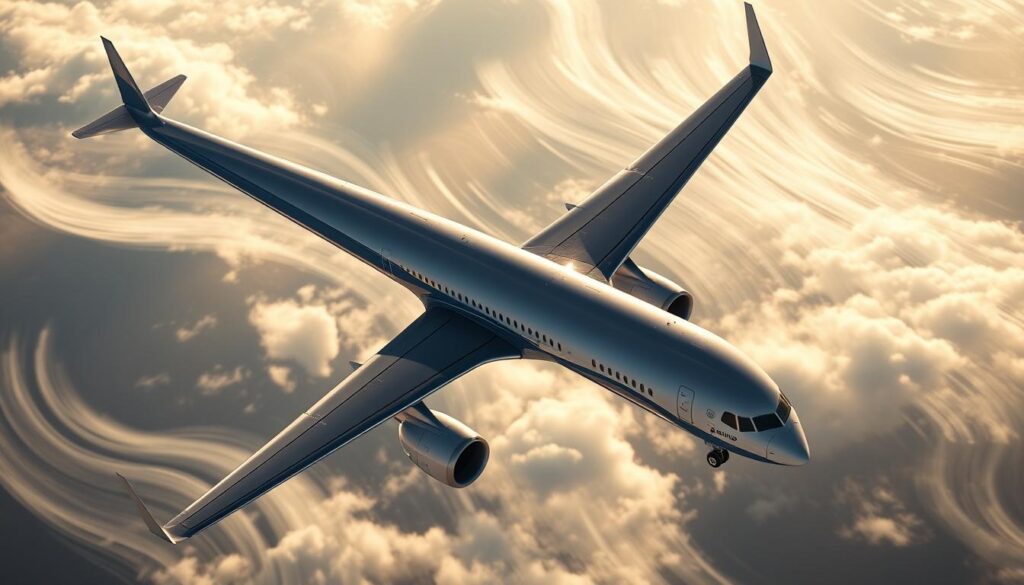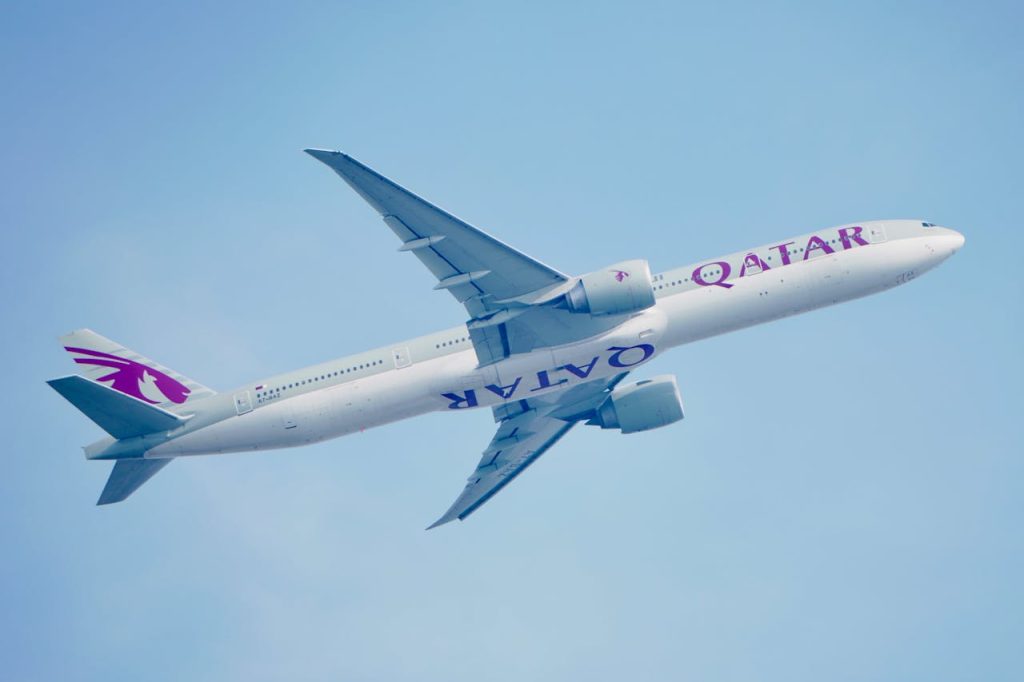Have you heard that Boeing 737 aircraft have finished over 184 million flights since they started flying? The Boeing 737-800 is one of the most used aircraft ever. It’s known for its great efficiency and reliability. It also has advanced tech and design that airlines all over the world love.
Since 1997, the Boeing 737-800 has been a key part of modern airlines. It can carry lots of passengers and has better engines and bigger wings. For more details on this aircraft, visit Boeing’s official page.
Let’s explore what makes the Boeing 737-800 a leader in commercial aviation. We’ll look into its specs and abilities.
Key Takeaways
- The Boeing 737-800 is a key model in the 737 family, known for its versatility.
- Over 184 million flights by the Boeing 737 family showcase its reliability.
- The aircraft is designed to accommodate between 108 to 215 passengers.
- With enhanced technology, the 737-800 remains a leader in operational efficiency.
- This model plays a significant role in shaping global airline fleets.
Introduction to the Boeing 737-800
The Boeing 737-800 is an important plane in the Next Generation series. It is known for being versatile and can easily handle short to medium routes. Since its introduction in the late 1990s, it has become popular for its fuel efficiency and ability to carry many passengers.
This model can fit 162 passengers in two classes or up to 189 in one class. It’s chosen by airlines for its flexibility, useful for both domestic and international trips. Its range of over 3,000 nautical miles meets various needs.
Many airlines, including Ryanair, have a large number of Boeing 737-800s. Its success shows its value in the plane market. The plane’s growth and improvements keep it relevant. For more details, check this page.
History and Development of the Boeing 737 Family
The Boeing 737 family’s journey started in the early 1960s. It was created to meet the need for an efficient aircraft for short routes. The original designs had engines at the back, which brought new advantages in air movement. However, the design saw changes when they noted the benefits of engines under the wings. Such improvements enhanced efficiency and flight performance. The introduction of the Boeing 737-100 in 1968 was a big step, leading to a range of aircraft models for different numbers of passengers.
Initial Design Concepts and Launch
Initially, the Boeing 737 was made for short regional trips. It aimed to mix comfort with efficiency. The launch of the first model led to more versions within the family. Changes from the first design to the actual plane focused on better passenger experience and dependability. Moving engines from the rear to underneath the wings showed a strong commitment to being innovative.
Generational Evolution of the 737 Model
Over its history, the Boeing 737 has evolved greatly. Each new series brought improvements in fuel use, comfort, and tech. The Original series started with the 737-100 and 737-200. Then, the Classic series came with the 737-300, -400, and -500, improving performance. The Next Generation series included the 737-600, -700, -800, and -900, which boosted efficiency and capability. Finally, the MAX series with the 737 MAX 7, 8, and 9, shows the peak of design and engineering in the Boeing 737.
Aircraft Specifications of the Boeing 737-800
The Boeing 737-800 is a key player in the 737 family due to its efficiency and versatility. Its specifications offer insights into its global preference among airlines. Dimensions, engines, and performance numbers are crucial in understanding its abilities.
Dimensions and Weight
The Boeing 737-800’s size enhances its performance and how many passengers it can carry. It is 39.5 meters long and has a wingspan of 35.8 meters. With a height of 12.5 meters, it suits different passenger travel setups. Its maximum takeoff weight is around 79,000 pounds, able to carry lots of cargo and people far and wide.
Engines and Performance Metrics
Powered by CFM56-7B engines, the Boeing 737-800 offers a strong thrust of about 26,000 pounds per engine. It cruises at Mach 0.79, perfect for various flight lengths. It can fly up to 2,935 nautical miles, proving its value for many airlines.
Passenger Capacity and Comfort Features
The Boeing 737-800 is known for its large passenger capacity and comfort features that make trips better. Many airlines design their Boeing 737-800 planes to balance space and comfort perfectly, fitting passengers in smoothly.
Seating Configurations
Different airlines have various seating layouts for the Boeing 737-800. These setups usually offer between 162 to 189 seats. American Airlines, for example, uses a two-class arrangement. They provide 16 first-class and 156 economy-class seats. This smart design maximizes space and meets various passenger needs, making flights more comfortable.
In-Flight Amenities for Passengers
The Boeing 737-800 comes with many features to make flying better. Passengers can find in-seat power outlets, large overhead bins, and advanced air systems. Airlines add custom services like entertainment and various meals to make your journey nicer. These amenities greatly improve the flying experience, making the Boeing 737-800 a favorite among airlines and travelers.

Fuel Efficiency and Economic Benefits
The Boeing 737-800 is a standout in commercial flight, known for fuel savings and money benefits. Airlines flying this jet gain lots from its efficiency and low costs. These advantages highlight the plane’s part in fostering both sustainability and economic success.
Operating Costs Compared to Other Aircraft
The Boeing 737-800’s operating costs are way lower than other planes. It uses about 34% less fuel than older versions. This means big savings for airlines. Below is a comparison of the Boeing 737-800’s operating costs to two other models:
| Aircraft Model | Average Fuel Burn (liters/100 km) | Operating Costs (per flight hour) |
|---|---|---|
| Boeing 737-800 | 2.9 | $2,500 |
| Airbus A320 | 3.2 | $3,000 |
| Bombardier CSeries | 3.0 | $2,800 |
Environmental Impact and Efficiency Ratings
The Boeing 737-800 has made big steps in cutting its carbon footprint. This helps airlines meet sustainability goals. Its high efficiency ratings show it’s good for the planet. This draws in eco-aware customers and meets regulations.
Flight Performance and Range of the Boeing 737-800
The Boeing 737-800 shines in the commercial flight world. It can fly more than 2,900 nautical miles without stopping. This makes it easy for airlines to link big cities directly. Its great agility and smooth control offer pilots a dependable experience in different flying conditions.
This plane’s range lets airlines connect far places with no stops. This boosts how well airlines work and makes trips better for passengers. The shorter travel times mean more comfort, which is why this plane is a favorite in many fleets.

To sum up, the Boeing 737-800 is known for its strong flight ability and long range. It stands out in the busy world of flying because of its latest tech and top-notch design. This plane keeps up with what airlines and travelers need today.
Cockpit Technology and Pilot Experience
The Boeing 737-800 boasts amazing cockpit technology, greatly improving the pilot’s journey. It has a modern glass cockpit, making flight navigation and management better.
The mix of automation and advanced displays aids pilots. They gain improved awareness, which leads to smoother flights.
Advancements in Cockpit Design
The Boeing 737-800’s cockpit technology has come a long way. Its design focuses on being useful and easy to access, giving pilots the best tools. These tools help pilots perform better.
Visual displays show critical flight info quickly. This helps pilots concentrate on important tasks. Safety and efficiency get a big boost from this technology.
Ease of Use for Pilots
The cockpit of the Boeing 737-800 was made with ease in mind. Its layout lessens the amount of work for pilots. This makes learning to operate the aircraft faster and more effective.
Its controls and interfaces are simple to use. Pilots can handle various flight tasks with ease. This design choice makes flying safer and more efficient in different weather conditions.
| Feature | Description | Benefits |
|---|---|---|
| Glass Cockpit Design | Modern display technology showing critical flight data | Improved situational awareness |
| Automation Systems | Integrated systems to aid with navigation and monitoring | Reduced pilot workload |
| User-Friendly Interfaces | Intuitive controls that simplify aircraft operation | Enhanced training efficiency |
| Enhanced Display Systems | High-resolution screens for clear information delivery | Quick access to vital data |
Current Usage in Airline Fleets
The Boeing 737-800 is a major player in the world of flying. It’s known for doing well on shorter trips and also on flights that are a bit longer. Many airlines keep choosing it for its good performance and ability to adapt.
Key Operators of the Boeing 737-800
Lots of airlines have a big number of Boeing 737-800 planes. American Airlines is at the top with 303 of them, more than any other airline worldwide. Southwest Airlines and Ryanair also have many, using them regularly to carry their passengers.
Trends in Fleet Expansion and Usage
Airlines are growing their fleets and often pick the Boeing 737-800 to help. They are swapping old planes for new ones to be more reliable and efficient. This model is a key part of their plans, used a lot both in the U.S. and for going to other countries.
| Airline | Fleet Size | Primary Routes |
|---|---|---|
| American Airlines | 303 | Domestic & International |
| Southwest Airlines | 230 | Domestic |
| Ryanair | 75 | European Routes |
The Role of the Boeing 737-800 in the Aviation Industry
The Boeing 737-800 plays a key part in the aviation world. It’s known for its strong build and ability to adapt. It has become vital for flights that are not too long but not too short. This jet is great for both traditional and budget airlines. It carries lots of passengers without spending too much money.
Many airlines pick the Boeing 737-800 for different journeys. It makes flying accessible to more people. Its reliable name means it’s often the first choice when airlines grow their fleet. The Boeing 737-800’s efficiency helps airlines make more money in a tough market.
The Boeing 737-800 does more than just fly people around. It has changed how we connect different places by air. As the world of flying changes, this jet keeps playing a crucial role. It shows how important versatile planes are in meeting what travelers need.
| Feature | Boeing 737-800 | Competitor Aircraft |
|---|---|---|
| Passenger Capacity | 162-189 seats | 150-180 seats |
| Range | 2,935 nautical miles | 2,500 nautical miles |
| Fuel Efficiency | 0.4 L/passenger km | 0.5 L/passenger km |
| Typical Role | Mainline/Regional Operations | Regional Operations |
Challenges and Future of the Boeing 737-800
The aviation world is always changing. This means the Boeing 737-800 faces challenges to stay on top. With newer planes coming out, we need to tackle competition and changes in rules that impact how we operate.
Market Competition with Newer Aircraft
Lately, the Boeing 737-800 is facing tough competition from newer planes like the Airbus A320neo. These new models are more fuel-efficient and better for the environment. To keep up, the Boeing 737-800 must keep improving and show why it’s still a great choice.
Impact of Regulatory Changes on Operations
Changes in regulations greatly affect how the Boeing 737-800 operates. As safety and environmental standards get tougher, it’s important to stay compliant. This means changing how we maintain and operate the plane. Being able to adjust will be key to the Boeing 737-800’s future success.
Conclusion
The Boeing 737-800 is a key player in commercial aviation. It combines efficiency, comfort, and versatility remarkably. It’s not just a mainstay for airlines but a reflection of the industry’s ability to meet evolving passenger and operational needs. The Boeing 737-800 showcases the best in modern engineering and design, making flying an exceptional experience.
Looking ahead, the Boeing 737-800 will remain vital in airline fleets worldwide. Its proven reliability and performance make it a favorite among carriers. With new challenges ahead, like changing regulations and more competition, its flexibility makes it well-suited to stay relevant.
The Boeing 737-800’s lasting success highlights its important role in aviation. By understanding its strengths, we see how it will handle future air travel complexities. This cements its place as a foundational element in our industry.


